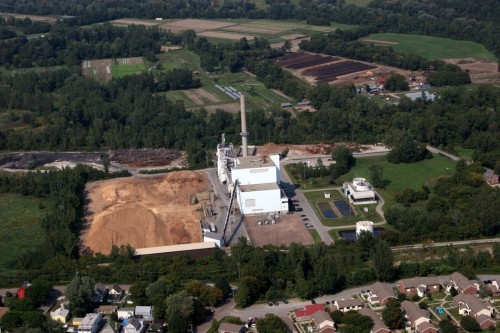Facing climate change: Vermont’s biggest polluters
May 29, 2013. Source: Audrey Clark, VT Digger

Vermont’s reputation as a green state was upheld this year when the U.S. Environmental Protection Agency (EPA) released an interactive map of the biggest point sources of greenhouse gases in the country. In spite of, or thanks to, these facilities, Vermont has the lowest emissions in the nation.
Even so, Vermont’s six biggest polluters are not moving fast enough to meet the state’s goal of reducing emissions 75 percent below 1990 levels by 2050.
The EPA map shows facilities, mostly industrial, that release more than 25,000 metric tons of greenhouse gases into the atmosphere. Vermont’s biggest polluters total 849,068 metric tons of greenhouse gases, about 10 percent of Vermont’s total emissions.
In order of decreasing emissions, the facilities are the J.C. McNeil biomass generating plant, IBM, Moretown Landfill, Coventry Landfill, RockTenn paperboard recycling company, and the University of Vermont.
These six facilities have already taken measures to lower their emissions, and some have plans to do even more. Federal and state regulation of greenhouse gases Facilities that release more than 25,000 metric tons of greenhouse gases are required to report their emissions to the EPA. This accounts for nearly all power plants and refineries, as well as other large industrial facilities. The latest data are from 2011 and are not yet completely verified by the EPA. The gases reported to the EPA are converted into a single number called carbon dioxide equivalent, a measure of the warming effect of each gas expressed in units of carbon dioxide.
Doug Elliott, the section chief of the air pollution control division at the Vermont Agency of Natural Resources, said Vermont doesn’t do much to regulate greenhouse gas emissions. The EPA delegates Vermont to monitor and enforce emissions levels of any big polluter. Elliott said a facility has to release 100,000 metric tons of CO2e before the state and federal governments start looking over its shoulder, a threshold Elliott called “very high.”
Currently, keeping an eye on the big polluters isn’t taking up much of the air pollution control division’s resources because there are so few facilities in Vermont that exceed the federal limits. But, said Elliott, “There is talk of reducing that threshold and depending on where they reduce that threshold to it could bring in an absurd number of permits that we wouldn’t have resources for.” The air pollution control division spends the majority of its time regulating permits for gases that make up a much smaller part of emissions — like sulfur dioxide and carbon monoxide — which have traditionally been considered more toxic than carbon dioxide.
Vermont’s big six Out of Vermont’s six big greenhouse gas polluters, the J.C. McNeil generating plant in Burlington’s Intervale polluted the most, accounting for 42 percent of the state’s large-facility emissions. Vermont’s largest biomass power plant released 355,606 metric tons of CO2e in 2011. Ninety-seven percent of that came from wood biomass; the rest was natural gas burned to meet electricity demand.
John Irving is the power supply manager for Burlington Electric. He says wood energy has net-zero emissions in the long run. “It’s pretty close to a closed cycle,” he said. Some, like Irving, argue wood energy is carbon-neutral because trees grow back and reabsorb carbon dioxide.
Other scientists challenge that idea, arguing that wood is less efficient than most fossil fuels and that trees take a long time to grow back, longer than we have to reduce emissions.
Christopher Kilian of the Conservation Law Foundation says the jury’s still out on biomass’ impact on carbon sequestration, but that “it isn’t fair to take a biomass plant and just lump it in with a bunch of coal plants or other facilities that are emitting a bunch of methane from a bunch of rotting garbage or greenhouse gases from manufacturing. It is a renewable fuel and there is a carbon cycle associated with that facility.”
Nonetheless, Kilian would like to see McNeil become more efficient by, for example, reusing waste heat.
- See more at: http://vtdigger.org/2013/05/29/facing-climate-change-vermonts-biggest-polluters/#sthash.BKernnvl.dpuf

